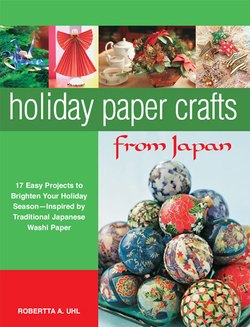Читать книгу Holiday Paper Crafts from Japan - Robertta A. Uhl - Страница 7
На сайте Литреса книга снята с продажи.
ОглавлениеShopping
for Washi
All around the world, the changing seasons are marked with joyful celebration. Christmas commemorates one of the most important festivals of the year, even in Japan. Many Japanese department stores are decorated with Christmas trees, twinkling lights, and holiday music just like the stores in many other parts of the world. Even though Christians are a minority in Japan, the Japanese love festivals and Christmas coincides with many of the end-of-year events of gift giving around December and January each year.
Like all of us, the Japanese enjoy giving unique and creative gifts. The wonderful holiday gifts in this craft book will help the creative crafter to surprise friends and loved ones with handmade gifts in their favorite holiday colors.
Since Washi is the main material in all of the crafts in this book, choosing the design and pattern is particularly important. Study the craft that you would like to make and find the design and pattern that will show off the color and design of that Washi. If a pattern is too large it will disappear when making a small ornament, whereas if it is small and you can clearly see the details, it will show off the craft you are making. Likewise, if you are making a large craft, you will need to pick the appropriate paper to best highlight the larger scale of the project.
The choices are endless and often the search for the right paper is just the beginning of enjoying the creative process. You will find that there are very few traditional Christmas-themed Washi, but many of the wonderful designs and colors will work well for the holidays.
Sizes: The standard size of a full sheet of printed Washi is 26" x 39" (66 x 99 cm). Some companies make smaller sheets, so it is wise to measure the sheets before buying. Some stores sell their printed Washi rolled up in plastic packaging with the size marked on the plastic cover. In Japan, the larger craft stores display their Washi flat in drawers or loosely folded and placed on specially designed wooden shelves.
One-way patterns: Some printed Washi papers have definite one-way patterns. You will need to take this into account when doing certain projects. It is wise to buy a little extra printed Washi to ensure that the pattern is able to go in the same direction all around your project.
Economizing: When purchasing printed Washi, it is more economical to purchase full sheets than smaller pieces. If you want to have a variety of printed patterns at your disposal, try getting together with a group of friends to purchase a large number of full sheets of printed Washi that can then be divided up among the group, sharing the expense.
Borders: Full sheets of printed Washi have a solid, unprinted border around the outer edges. These edges should not be discarded but kept for covering the holes when making Washi-covered eggs.
Internet sites: Washi has become very popular in recent years and there are a large number of Washi sites on the internet that sell Washi paper of all kinds, as well as instruction kits and books. Some of the more popular sites are www.washiart.com, www.kura.com, www.shizu.com, www.aitoh.com, www.kimscrane.com, and www.ichiyoart.com. The forthcoming site www.washiways.com will carry my books Japanese Washi Paper Crafts and Holiday Paper Crafts from Japan, selected Washi paper packets for specific craft items, kits, and supplies.
